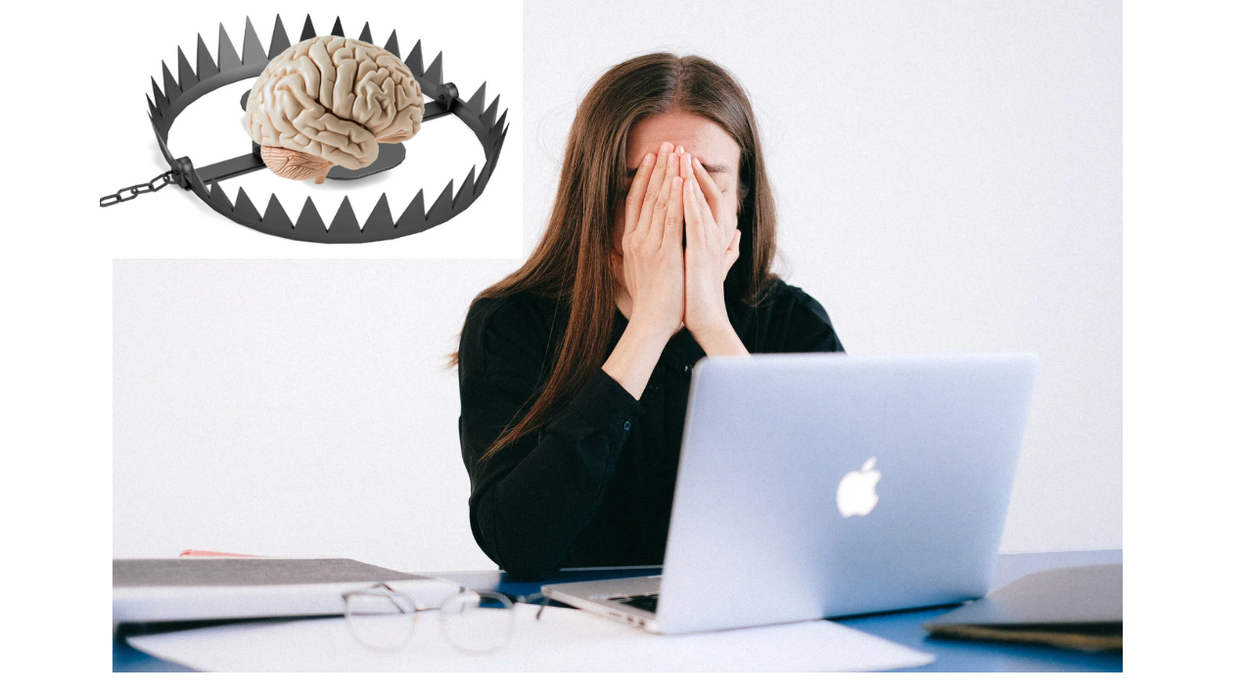Hate to break it to you, but you’re not always in complete control of your thinking. Your decisions and thoughts are constantly influenced by outside forces and biases deep within your brain, or that are just hardwired through life experience, evolution, and so on. We don’t always think about how we’re thinking, and it could get us stuck in life.
Fortunately, the folks at Escaping Ordinary have cooked up an extensive list of the most common “mind traps” that have been taken from the Nobel Prize-winning behavioral psychologist Daniel Kahneman and his book Thinking, Fast and Slow. They have found 21 fallacies, biases, and other concepts that could interfere with logical, thoughtful thinking. We’re only going to go over ten of them—and note you may not be able to control them all—but recognizing them could help you make better decisions.

1. Cognitive Dissonance
Have you ever tried to build IKEA furniture and quit midway saying it was junk anyway? This is Cognitive Dissonance, a belief (“This IKEA bookcase would be great!”) versus a new belief (“Meh, that bookcase sucked anyway.”). Instead of acknowledging your limitations and improving upon them (furniture assembly, in this case), you write it off as worthless and don’t improve.
2. The Halo Effect
The Halo Effect makes us cling to the first piece of information rather than the entire sum, especially when it’s positive. Positive first impressions influence the rest of our thinking, making objectively bad ideas or people seem better or trustworthy. It’s why many people stay in toxic romantic relationships—they remember and cling to the initial attractive qualities instead of stepping back to analyze the entire personality of their partner.
3. Confirmation Bias
Confirmation Bias is when you have an existing belief and try to find evidence to enforce that belief while unintentionally discarding any evidence that conflicts with that belief. Our egos keep us from wanting ourselves to think we’d believe in something false for so long. Hence, confirmation bias often keeps us from expanding our knowledge and has us filter the information we pay attention to. Even smart people make this mistake instead of retesting theories and asking bigger questions.
4. The Spotlight Effect
Ever go to a party thinking everyone notices that pimple on your cheek? The Spotlight Effect is when people determine that others are observing them more than they are. In reality, very few people or no one actually notices, and if they do notice, they don’t really care. So, just have fun, don’t be anxious, and don’t worry about the blemish.
@gamblingguard here’s why that’s a good thing… #spotlighteffect #psychology #mensmentalhealth
5. The Anchoring Effect
When you’re entering an auto dealership, you’re entering a world of the Anchoring Effect. Have you ever seen the ridiculously expensive sticker price on a car then a slash over it with a new, lower price? It looks like a much better deal, but is it really? The dealer is actually using your “anchors” of price expectations to make it seem better when the “deal” is the profitable price they wanted you to pay in the first place.
6. The Baader-Meinhoff Phenomenon
Continuing from the previous entry, let’s say you didn’t fall for the Anchoring Effect at the dealership and bought a Nissan Cube. You never noticed it before, but all of a sudden you start seeing Nissan Cubes at the grocery store parking lot, in your neighborhood, and everywhere. This is the Baader-Meinhoff Phenomenon. It’s an illusion that something appears more often, but it was always there. You just hadn’t bothered to notice it before.
7. The Contrast Effect
This is another one that can apply to shopping. Paying $699.00 for wheels for a Mac Pro computer seems incredibly expensive and you’d probably look for cheaper options if you were buying the wheels alone for a computer tower. However, your brain might think it’s not so bad if you’re buying them alongside a new $6,999.00 Mac Pro. It’s best to check yourself to make sure you’re not getting upsold through comparison and contrast.
8. The Zeigarnik Effect
If you’re a person who hyper focuses on incomplete tasks to the point in which it’s causing anxiety and you’re ignoring all that you did finish or accomplish, you’re a victim of the Zeigarnik Effect. Psychologists say the best method to combat the negative impact is to handwrite your tasks down on a note pad to not only remind you of what is unfinished and needs to be checked off, but also to have a written history about all that you have accomplished once you complete those tasks so you can be kinder to yourself.
9. The Paradox of Choice
If you’re subscribed to Netflix or some other streaming service, it’s because they offer hundreds of different movies and TV shows, right? But how many times do you spend long periods of time scrolling through them all, feeling fatigued, and doing something else instead? This situation is the Paradox of Choice. We tire ourselves out because there are so many options in front of us that we end up choosing nothing out of mental paralysis. If presented with a smaller size of potential picks, it’s easier for our brains to weigh pros and cons while also feeling good about the final decision, since there is less chance of missing out on something better.
10. Gambler’s Fallacy
Ever see a gambler who thinks that, since the roulette wheel landed on black three times, it’s best to bet on red? Or did you take a multiple-choice test and pick option C even though B felt like the right answer because you had already chosen B in the previous two questions? It feels like it should change, even though statistically everything is the same. That’s the root of the Gambler’s Fallacy. It’s best to remember that there’s no “balancing force” behind guesses, choices, and chance.
Knowing and recognizing all of these may help you better understand how your brain works, and, hopefully, lead to better decisions in the long term. If you want to know about other cognitive concepts that could be hindering your progress or interfering with your day-to-day life, you can learn about the 11 other mind traps in Escaping Obscurity’s video below.
- YouTubeyoutu.be





















 There are plenty of low or no-cost date ideas.Canva
There are plenty of low or no-cost date ideas.Canva Couples can energize their relationship by finding bonding moments that reignite their wonder.Canva
Couples can energize their relationship by finding bonding moments that reignite their wonder.Canva



 A family holding hands.
A family holding hands.